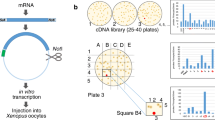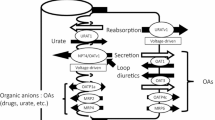Abstract
Full-length cDNA gene of sodium-dependent dicarboxylate co-transporter protein 1 (SDCT1) is cloned from normal human kidney tissue and inserted into EGFP (enhanced green fluorescent protein) expression vector along with N-terminal and C-terminal truncated SDCT1 genes, so to construct the eukaryotic expression vectors of EGFP/SDCT1 fusion proteins, which are transfected into human renal tubular epithelial cells (HKC). Subcellular localizations of these fusion proteins are observed by laser confocal microscope to determine the localization signal of the SDCT1 protein. Duplex PCR analysis validates that the fusion protein genes have been integrated into the genome of HKC. Western blot indicates that the fusion proteins have been expressed in HKC. Confocal microscopy analysis shows that human SDCT1 predominantly locates on the plasma membrane, which is consistent with the results predicted by bioinformatics approach; in HKC transfected with N-terminal truncated SDCT1 gene, the green fluorescence is mainly distributed on the plasma membrane; in HKC transfected with C-terminal truncated SDCT1 gene, the green fluorescence is mainly distributed in the cytoplasm. EGFP/SDCT1 mRNAs obtained by in vitro transcription are microinjected into Xenopus laevis oocytes for expression and the trans-membrane currents are measured by using two-microelectrode volt-age-clamp technique. Na+ inward currents are present on cellular membrane of the injected oocytes. Immunohistochemical staining shows that human SDCT1 proteins are expressed on lumen membrane of the renal proximal tubule, but are negative in distal tubule, collecting duct, renal interstitium and glomerulus. The above-mentioned studies suggest that human SDCT1 protein is located on the lumen membrane of the renal proximal tubule, the C-terminal sequence of the SDCT1 is required for delivery and targeting localization, and the plasma membrane localization signal of the SDCT1 protein maybe locate in the C-terminal sequence.
Similar content being viewed by others
References
Pajor, A. M., Gangula, R., Yao, X. Z., Cloning and functional characterization of a high-affinity Na+/dicarboxylate cotransporter from mouse brain, Am. J. Physiol. Cell Physiol., 2001, 80: C1215-C1223.
Chen, X. M., Tsukaguchi, H., Chen, X. Z. et al., Molecular and functional analysis of SDCT2, a novel rat sodium-dependent dicarboxylate transporter, J. Clin. Invest., 1999, 103: 1159–1168.
Pajor, A. M., Sun, N. N., Molecular cloning, chromosomal organization, and functional characterization of a sodium-dicarboxylate co-transporter from mouse kidney, Am. J. Physiol. Renal. Physiol., 2000, 279: F482-F490.
Pajor, A. M., Citrate transport by the kidney and intestine, Seminars in Nephrology, 1999, 19: 195–200.
He, Y. N., Chen, X. M., Yu, Z. H. et al, The change of humanNa+/ dicarboxylate co-transporter 1 expression in the kidney and its relationship with pathogenesis of nephrolithiasis, Natl. Med. J. China, 2001, 81 (17): 1066–1070.
Wu, D., Chen, X. M., Ye, Y. Z. et al., Expression of citrate transporter mRNA in the kidneys of rats with metabolic acidosis, Acta Physiol. Sin., 2000, 52 (1): 55–58.
Rogina, B., Reenan, R. A., Nilson, S. P. et al., Extended life-span conferred by cotransporter gene mutations in Drosophila, Science, 2000, 290: 2137–2140.
Knauf, F., Rogina, B., Jiang, Z. et al., Functional characterization and immunolocalization of the transporter encoded by the life-extending gene Indy, Proc Natl. Acad. Sci. U.S.A., 2002, 99: 14315–14319.
Masoro, E. J., Caloric restriction and aging: An update, Exp. Gerontol., 2000, 35:299–305.
Sohal, R. S., Weindruch, R., Oxidative stress, caloric restriction, and aging, Science, 1996, 173: 59–63.
Milon, B., Dhermy, D., Pountney, D. et al., Differential subcellular localization of hZip1 in adherent and non-adherent cells, FEBS Letters, 2001, 507:241–246.
Ma, C.S., Ning, J.Y., You, J.F. et al., Primary functional identification of gene TMSG-1, Sci. in China, Ser. C, 2003, 46(6): 641–650.
Author information
Authors and Affiliations
Corresponding author
Rights and permissions
About this article
Cite this article
Bai, X., Chen, X., Fen, Z. et al. Expression of EGFP/SDCT1 fusion protein, subcellular localization signal analysis, tissue distribution and electrophysiological function study. Sci. China Ser. C.-Life Sci. 47, 530–539 (2004). https://doi.org/10.1360/03yc0044
Received:
Revised:
Issue Date:
DOI: https://doi.org/10.1360/03yc0044




